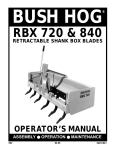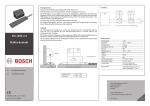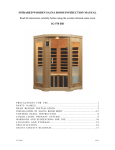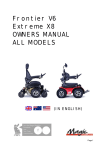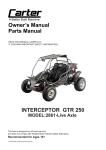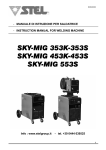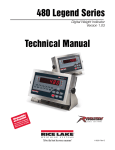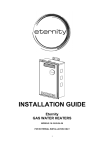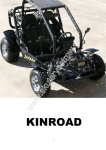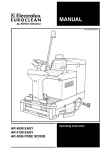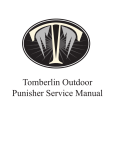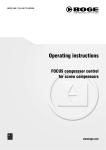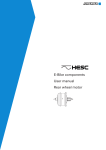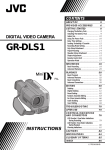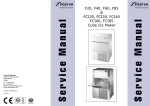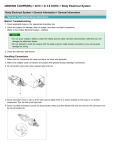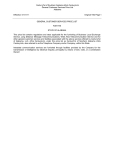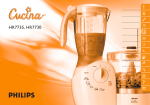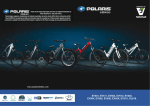Download Carter Brothers Talon 150 DLX / FX / GX / Service Manual
Transcript
Service Manual Talon 150 GX/FX/DLX Series FOREWORD This service manual has been specially prepared to provide all the necessary information for the proper maintenance and repair of the DLX/FX/GX. The DLX/FX/GX fits the needs of a wide variety of kart users above 16 years old. Those who will be servicing this kart should carefully review this manual before performing any repair or services. All information, illustrations photographs and specifications contained in this manual are based on the latest product information available at the time of publication. Due to improvements or other changes, there may be some discrepancies in this manual. Therefore, if newest information is requested in the future, please contact the local distributor. Distributor reserves the right to make production changes at any time, without notice and without incurring any obligation to make same or similar changes to vehicles previously built or sold. Carter Brothers 1871 U.S. Highway 231 Brundidge, AL 36010 Tel: 334.735.2301 Web: http://www.carterbro.com ii TABLE OF CONTENTS GENERAL INFORMATION 1 PERIODIC MAINTENANCE AND TUNE-UP PROCEDURES 5 ENGINE 9 LUBRICATION SYSTEM 24 FUEL SUPPLY SYSTEM 28 TRANSMISSION COMPONENTS 33 ELECTRICAL STARTING SYSTEM 36 BELT DRIVE CVT MECHANISM 42 CLUTCH 46 REAR TRANSMISSION SYSTEM 51 ELECTRICAL SYSTEM 56 IGNITION SYSTEM 62 CHASSIS 66 WIRING DIAGRAM 72 INDEX 73 iii GENERAL INFORMATION MODEL IDENTIFICATION FRAME NUMBER The frame number or VIN is stamped under the seat on the frame cross member and on a sticker behind the seat. ENGINE NUMBER The engine number is located on the lower front left side of the engine case. FUEL AND OIL RECOMMENDATIONS Be sure to use the specified fuel and oil. FUEL Gasoline should be 85 to 95 octane or higher. Unleaded gasoline is recommended. ENGINE OIL A high-grade 10W-40 motor oil should be used. BREAK-IN PROCEDURE • For the first 2hours of riding, do not exceed 2/3 throttle. • Vary engine speed for the first 5 hours. • Never hold engine at full throttle for long periods of time. 1 SPECIFICATIONS DIMENSIONS Overall length Overall width Overall height Wheelbase Front Track Rear Track Ground Clearance 2075mm (87.7 inch) 1235mm (48.6inch) 1400mm (55.1inch) 1450mm (57inch) 1060mm (47.1inch) 1000mm (39.4inch) 130mm (5.1inch) ENGINE Type Engine capacity Bore x stroke Corrected Compression Ration Carburetor Output Power Maximum Torque [N.m(r/min)-1] Starting Ignition Lubrication Transmission CAPACITIES Load Fuel tank Starting Climbing CHASSIS Front Brake Rear Brake Front Tire Rear Tire Suspension-Front Suspension-Rear Brake Track Top Speed Forced air – cooled 4 strokes 150cc 57.4 x 57.8 9.2: 1 PD25J 9HP/7500rpm 8.0/4000-4500 Electric CDI Force & Splash Automatic CVT 1 rider or 90kg/198Ibs 7L/1.54Gal 5s 20-25° Hydraulic disc/left foot control Hydraulic disc/left foot control 19 x 7.0-8 18×9.5-8 or 22×10-10 Dual A-arm with 1.8” (45mm) of travel Spring over shock with 2.4”(60mm) of travel 7m@20miles/h 30miles/h(or limited as customers require) 2 WEIGHT Dry Weight 155kg/341lbs TIRE PRESSURE Front Rear 2.9Psi (20kPa/cm2, 0.2kgf/cm2) 2.2Psi (15kPa/cm2,0.15kgf/cm2) WARRANTY Parts & Workmanship 6 months * The specifications are subject to change without notice. 3 LOCATION OF PARTS 4 PERIODIC MAINTENANCE AND TUNE-UP PROCEDURES PERIODICAL CHECK AND SERVICES The maintenance intervals in the following table are based upon average riding conditions. Riding in unusually dusty areas requires more frequent servicing. Items Needing Servicing Tire pressure/wear Brake performance Tightness of screws Air cleaner Carburetor Spark plug Drive chain Brake fluid Replace gearbox oil Chassis Fuel switch/fuel tank Battery Engine oil Valve clearance of engine Initial Service (first week) I I I I I Monthly I I I C A I I C, L Quarterly Yearly C I C C, A C, A, L I R L C I I R A A: Adjust C: Clean I: Inspect, clean or replace if necessary L: Lubricate R: Replace MAINTENANCE AND TUNE-UP PROCEDURE Descriptions of the servicing procedures for each item in the Periodic Maintenance requirements. SPARK PLUG Note: The spark plug should generally be serviced when the engine is cold. • Clean up the carbon around the spark plug to prevent it from dripping into the cylinder when being removed. • Remove the spark plug • If the spark plug is too tight to remove, spray rust inhibiter on the spark plug washer and the thread. After soaking for a few minutes, the spark plug should easily unscrew. • Clean up any dirt and carbon accumulation on the spark plug with a steel brush or a blade. • Inspect the spark plug gap, it should be about 0.6 ~ 0.7mm. • When the carbon accumulation and wear of the spark plug are too severe, replace the spark plug with one of the same specification. 5 TIRE PRESSURE/WEAR Check the tire pressure every time the kart is ridden. The tire pressure is very important for the stability of the ride. Tire Pressure Front Rear 2.9 psi 2.2 psi 20kPa/cm2 15kPa/cm2 0.20kgf/cm2 0.15kgf/cm2 BRAKE PERFORMANCE • Always check that there is plenty of brake fluid in the brake fluid reservoir. • Check that the rear brake pads are in good condition. • Check the brake rotor for abnormal wear. AIR CLEANER Note: Clean after every 20 hours of use, or more often if used in a dusty environment. If the air cleaner is clogged with dust, performance will be severely decreased and if left unserviced, engine damage can occur. Check and clean in the following manner. Paper Filter Maintenance • Remove the air cleaner from its housing • Tap filter on a hard object to knock dust from the filter • Replace the element if it is wrinkled or torn Foam Filter Maintenance • Remove foam filter from steel cage • Wash in non-flammable cleaning solvent • Submerge in oil and squeeze to remove excess oil • Install the element back into the air box. Caution! Before and during cleaning, inspect the element for tears. A torn element must be replaced. Make sure the element is seated proplerly and no foreign material can pass by. 6 CHASSIS NUTS AND BOLTS Note: Inspect the first week and then every month thereafter. Always pay attention to the karts nuts and bolts. Some loosening after use is a normal. Check to ensure that all nuts and bolts are tight. Torque Tightening Chart Bolt Diameter 4 5 6 8 10 12 14 16 18 Conventional Marked N.m Kg.m 1 ~2 0.1 ~0.2 1 ~4 0.2 ~0.4 4 ~7 0.4 ~0.7 10 ~16 1.0 ~1.6 22 ~35 2.2 ~3.5 35 ~50 3.5 ~5.5 50 ~80 5.0 ~8.0 80 ~130 8.0 ~13.0 130 ~190 13.0~19.0 Bolt Ib-ft 0.7 ~1.5 1.5 ~3.0 3.0 ~5.0 7.0 ~11.5 16.0~25.5 25.5 ~40 36.5 ~58 58 ~94 94 ~137.5 N.m 1.5 ~3 3 ~6 8 ~12 18 ~28 40 ~60 70 ~100 110 ~160 170 ~250 200 ~280 8.8 Marked Bolt Kg.m Ib-ft 0.15 ~0.3 1.0 ~2.0 0.3 ~0.6 2.0 ~4.5 0.8~1.2 6.0 ~8.5 1.8 ~2.8 13.0 ~20.0 4.0 ~6.0 29.0 ~43.5 7.0 ~10.0 50.5 ~72.5 11.0 ~16.0 79.5 ~115.5 17.0 ~25. 123.0 ~181.0 20 ~28.0 144.5 ~202.5 FUEL SWITCH (PETCOCK) • Periodically clean the petcock externally with grease remover and water. • Check for any leaks or seeping fuel. • Replace the petcock if there are any leaks found. This vehicle has a manually operated fuel calve. There are three positions. “ON” position The normal operating position for the fuel valve lever is the “ON” position. In the position, fuel will flow to the carburetor. “RES” position If the fuel level in the fuel tank becomes too low for the engine to operate with the fuel valve lever in the “ON” position, turn the lever to the “RES” position to use the reserve fuel supply, and refuel as soon as possible. “OFF” position The closing position for the fuel valve is the “OFF” position. When the vehicle is not in use, always make sure the petcock is in the “OFF” position. 7 FINAL GEAR OIL Note: Inspect monthly and change quarterly. Note: 80/90 weight gear oil is recommended in the final drive case. However, in extreme cold weather conditions, you may notice that the kart is hard to push. If that is the case, use lighter viscosity oil, such as 75 weight or equivalent motorcycle transmission fluid. • To check level, remove level screw on the left rear engine case. • To drain oil, remove the drain plug at the rear bottom of the engine case. It is recommended to warm the engine for 10 minutes or more draining final drive oil. Final drive capacity 80ml 80/90 weight ENGINE OIL Note: Inspect before each use. Change monthly. • Remove the drain plug from the left side bottom of the engine. Drain into oil pan for disposal. • Remove the large cap on the right bottom of the engine and remove the screen. • Wash the screen with cleaning solvent and refit, making sure the O-ring is still in good condition. • Refill the engine with 10W-40 engine oil and run for 5 minutes. • Check oil level on the filler cap stick to assure proper level. • The cap needs to be screwed in for a proper reading. CHASSIS Grease chassis bushings and bearings with grease quarterly to assure smooth operation and extended lift of the bushings and the components. If used in extreme wet and muddy conditions or dusty conditions, greasing is recommended more often. CARBURETOR Refer to Carburetor section. VALVE CLEARANCE Refer to Engine section. 8 ENGINE ENGINE COMPONENTS INSPECTION AND SERVICING ENGINE COMPONENTS AND CRANK CONNECTING ROD MECHANISM INSPECTION AND SERVICING ENGINE COMPONENTS: CYLINDER CYLINDER REMOVAL The removal can be done on the vehicle body. • Remove cylinder head. • Remove cylinder. • Remove cylinder gasket, bolts • Erase cylinder gasket. Caution! Do not damage the cylinder area. Make sure not to drop anything, including cylinder gasker material into the crankcase. CYLINDER INNER WALL WEAR INSPECTION Use a bore diameter dial gauge to measure the degree of wear. The measure point is divided into three sectional planes in the axial direction: upper, middle and lower; measure every plane each time on the mutually perpendicular directions (X, Y), the measured least dimension is the cylinder bore; at the most upper position measured is the largest diameter, and the lowest position measured is the smallest diameter, their difference is the cylindricity of the cylinder. At the same cross section, measured the difference of diameter between two points mutually perpendicular; which is the circularity of the cylinder. In order to make the measuring point perpendicular with the bore axis of the cylinder, and to ensure the precision of the measurement, the bar of the gauge can be slightly swung in the direction of the gauge bar, and take the smallest reading number as the result. In the situation without a dial gauge, a feeler gauge can be used to make relativity measurement, that is to put a new piston into the cylinder, and use the feeler gauge to measure the gap between the piston skirt and the cylinder wall, then figure out the abrasion loss of the cylinder. If the circularity of the cylinder exceeds the limit, then a cylinder reboring machine should be used to rebore the cylinder, and enlarge its diameter by 0.5mm or 1.00mm, then fit the piston and piston ring which size are also enlarged. If the wear is too severe and cannot be reworked, then a new cylinder should be installed. Cylinder bore Cylindricity Circularity 57.4mm 0.05mm 0.05mm 9 CRANK CONNECTING ROD MECHANISM: PISTON SET PISTON PIN INSPECTION AND SERVICING • Insert the piston pin horizontally into the piston pin hole, and inspect the clearance between piston and piston pin. Service Limit 0.02mm If the free play is too much, the worn condition of piston pin and piston pin hole must be inspected respectively. • Measure the external diameter of piston pin. Service Limit 14.98mm If the result is less than the Service limit, it should be replaced. After replacement, check the clearance between piston pin and piston pin hole and make sure it complies with the required measurement. • Measure the inner diameter of piston pin. Service Limit 15.02mm If the result is more than the service limit, it should be replaced. After replacement, check the clearance between the holes of the piston pin and make sure it complies with the required measurement. PISTON RINGS INSPECTION AND SERVICING • Inspect the piston ring for flaws, serious wear, or serious conglutination, etc. If there is, it should be replaced. • If the piston ring’s lateral clearance and notch clearance are too large or too small it will cause malfunctions, so it must be measured. • Measure the clearance of the piston ring in the piston ring groove. This clearance is the piston ring’s lateral clearance. First Ring Second Ring 0.09mm 0.09mm CONNECTING ROD END INSPECTION • Put the piston pin and bearing into the connecting rod end; inspect the degree of tightness of the piston pin in connecting rod end. • Measure the inner diameter of the connecting rod end. Service Limit 15.06mm When the abrasion of the bore exceeds the limitation, it should be replaced. 10 PISTON RINGS SET UP Before setting up, apply oil on each piston ring, then enlarge piston rings; at the same time put them on the piston and move downwards gradually, until piston rings fall into the ring groove. PISTON SET INSTALLATION • Remove the gasket attached to the crankcase. • Mount piston onto the small end of the connecting rod. The top of the piston marked with “IN” should be mounted towards the direction of the inlet port (if the mark is “EX”, then it should be mounted towards the direction of the exhaust port). • Mount piston pin and piston pin clip • Apply oil on the piston pin to lubricate it. Cover the crankcase port with a piece of cloth to keep the piston clip from dropping into the crankcase. CRANK CONNECTING ROD SET The connecting rod is the component that links the piston and crank. The picture shows the structure and assembling relations of the crank connecting rod component. CRANKCASE AND CRANKSHAFT REMOVAL Before removing the crankcase and crankshaft, follow these procedures: • Remove the engine. • Remove the cylinder cover. • Remove the cylinder. • Remove the piston. • Remove the drive plate and the driven plate. • Remove the AC generator. • Remove the starting motor. • Remove the oil pump. • Then remove the cam chain tensioner bolt. Remove the cam chain tensioner. • Use special tools to remove the starting driven gear. 11 • Remove the crankcase positioning bolts. • Separate the right crankcase and the left crankcase. Be careful not to damage the joint face. • Remove the gasket and the dowel pins. • Remove the crankshaft from the crankcase. • Take out the cam chain. • Remove the gasket on the crankcase joint face, be careful to not damage the joint face. • Remove the oil seal from the left crankcase. • Remove the oil seal from the right crankcase. 12 CRANKSHAFT AND CRANKCASE INSPECTION Replace the whole set of the crankshaft if serious wear is found while inspecting. Measuring the axial trend clearance of the big end of the connecting rod. When measuring, put the large end of the connecting rod close to the crank, and insert the feeler gauge between the other side and the crank, for the correct end play. Service Limit 0.55mm Measure the radial trend (X,Y) clearance of the big end of the connecting rod. Service Limit 0.05mm Measure the main shaft journal jump of the crankshaft. If the crank journal jump is too much it will cause the engine to shake abnormally, and shorten the lift of the engine, so it must be examined carefully when inspecting. Service Limit 0.10mm(A=90) 0.10mm(B=105) Examine if there is any loose, or unusual sound when the crank journal bearing turns, if there is, the whole set should be changed. After cleaning the crankcase, inspect if there is any damage. Inspect if the joint face of the crankcase is smooth and clean, and notice if it will affect the sealing performance between the left and right crankcase while reassembling. After the above inspection, if the crankcase has some surface damage, use oilstone to refinish it. If damage is too severe, replace the cover. Because the right and left crankcase axle hole must be concentric, they should be replaced at the same time. CRANKSHAFT AND CRANKCASE INSTALLATION • Mount the crankcase oil seal. • Put the cam chain into the left crankcase. • Put the crankshaft into the left crankcase. Pay attention to avoid damaging the oil seal with the cam chain. 13 • Mount the new dowel pins and gasket on the left crankcase. Then join the right crankcase and left crankcase together. • Tighten the crankcase positioning bolts. Tightening Torque 1.98 lbs/m • Mount the starting driven gear • Mount the cam chain tensioner • Mount the new O-ring on the cam chain tensioner bolt. • Apply some oil on the O-ring. • Tighten the cam chain tensioner bolt. The O-ring must be mounted in the groove. VALVE MECHANISM INSPECTION AND SERVICING The picture shows the common valve train of a four-stroke engine. This is a kind of overhead valve train, its intake port, exhaust port, cam shaft are all located in the cylinder head, the valves bottom up over the combustion chamber. GENERAL INTRODUCTION The four-stroke engine completes its four stroke with one piston stroke. • Intake stroke • Compression stroke • Expansion stroke • Exhaust stroke 14 VALVE CLEARANCE ADJUSTMENT Valve clearance is an important technical parameter in the valve train. In order to make sure that during any conditions, especially when the engine is overheated, or in cold conditions a certain clearance must be kept. This clearance is called valve clearance. When the engine is running, the valve clearance must not be too big or too small. So, valve clearance adjustment is an important procedure in the valve train maintenance. Remove the cylinder head cover. Inspection and adjustment should be done in cool conditions (below 35oC). Turn the cooling fan clockwise until the mark of the timing drive sprocket on the camshaft is at the top, dead center, and the “T” symbol (or other mark) of the magneto flywheel aligns to the crankcase mark. The crankshaft should corotate, or the exhaust port may not be adjusted. When adjusting, loosen the lock nuts, adjust the bolts with a valve-adjusting wrench when turned clockwise the valve clearance decreases. And when turned counterclockwise the valve clearance increases. Put a feeler gauge with specific sizes between the valve and rocket to check for correct clearance. Take out the feeler gauge, tighten the lock nuts, and then inspect the valve clearance again. Sometimes when tightening the lock nuts the clearance will change, so it must be rechecked for the proper clearance. Valve Clearance 0.08 ~ 0.12mm 15 CAMSHAFT The camshaft is a main driving unit of the valve train. The air inlet cam, the exhaust cam, and the cam journal are on the shaft. It controls the intake and exhaust valve to open and close at the correct time. Wear to the camshaft will affect engine performance and cause excessive noise. CAMSHAFT REMOVAL • Loosen valve cover bolts and remove cover. • Remove the cam chain tensional bolt cap, and remove the O-ring. • Tighten the cam chain tensioner by adjusting bolt clockwise. • Turn the flywheel counterclockwise to make the “ T” mark on the flywheel align with the mark on the crankcase. When the hole on the cam chain (timing drive chain wheel) is up, it should be at the top, dead center. • Remove the cylinder head positioning bolt. • Remove the camshaft holder bolt cap and washer. • Remove the camshaft holder and dowel pin. • Remove the cam chain wheel from the cam chain, and remove the camshaft. CAMSHAFT INSPECTION • Inspect the camshaft bearings for play, if there is replace the whole set. • Inspect cam surface for damage. • Measure the height of the cam. Inlet Cam Exhaust Cam 25.96mm 25.815mm 16 CAMSHAFT INSTALLATION • Rotate the flywheel to align the “T” mark on the flywheel with the camshaft mark. The round hole on the cam chain wheel should be up, and the left and right sit parallel with the cylinder head (the lobes of the camshaft are down). Then install the camshaft on the cylinder head. • Mount the cam chain on the chain wheel. • Install the dowel pins. • Mount the camshaft holder, washer and bolt cap on the cylinder head. • Tighten the cylinder head bolt and nut. While installing, apply some oil on the thread of the camshaft holder bolt. The camshaft nuts should be tightened diagonally in a 3-step process. After installing, adjust the valve clearance. • Turn the cam chain tensioner adjusting bolt counter-clockwise, and release the lock. • Apply oil on the new O-ring. • Mount and tighten the cam chain tensioner cover bolt. The O-ring must be mounted properly in the groove. • Replace the valve cover gasket, and mount the cover. The valve cover gasket must be properly mounted in the groove. • Tighten the valve cover-positioning bolt. ROCKER ARM AND ROCKSHAFT ROCKER ARM AND ROCKSHAFT REMOVAL • Remove the camshaft holder. • Take out the rockshaft by removing the bolt. • Remove the rocker arm. ROCKER ARM AND ROCKSHAFT INSPECTION Inspect if there is any abrasion or damage on the rocker arm and rockshaft or if the oil hole is clogged. If there is abrasion on the surface of the rocker arm, the camshaft should also be inspected. 17 • Measuring the inner diameter of the rocker arm. Service Limit 10.04mm • Measuring the outer diameter of the rockshaft. Service Limit 9.96mm ROCKER ARM AND ROCKSHAFT INSTALLATION Read the “ EX” mark on the camshaft holder, then mount the exhaust port rocker arm to the rockshaft. After that, mount the inlet port rocker arm to the rockshaft. Apply some oil on the rockshaft before mounting it on. CAM CHAIN TENSIONER The chain tensioner must be in good working condition for proper chain tension. 1. Cam chain 2. Cam chain tensioner 3. Cam chain tensioner lifter. 4. Gasket 5. Cam chain tensioner pivot 6. Cam chain guide 7. Bolt 8. Nut 9. O-ring 10. O-ring The operational principle of the tensioner is as shown in the picture. As for the adjustment of the cam chain tensioner, clockwise tightens, and counterclockwise loosens. 18 VALVE AND VALVE SPRING VALVE AND VALVE SPRING REMOVAL • Remove the cylinder head. • First remove the valve cotter with the valve compressor, then remove the upper spring race, valve spring, lower spring race, valve stem oil seal in turn. Remove the valve from the other side. The removed parts should be placed in order to avoid confusion. It’s better to place the intake valve parts and exhaust valve parts separately. VALVE AND VALVE SPRING INSPECTION • Inspect to see if the valve is bent or burned. • Inspect if the action is smooth between the valve and the valve guide. • Measure the outer diameter of the valve stem. Service Limit 4.94mm • Measure the free length of the inner and outer valve spring. Valve Inner spring Outer spring Inlet valve 31.2mm 34.1mm Exhaust valve 31.2mm 34.1mm Valve and valve spring installation • Mount the spring retainer, valve guide oil seal. It is recommended to replace the valve guide oil seal with a new one. • After applying oil on the valve stem, mount it into the valve guide. • Mount the inner and outer valve springs. • Mount the valve locker with a spring compressor. When mounting, the twisting direction of the inner and outer springs must be opposite. • Tap on the valve gently two or three times with a rubber hammer to make the valve and the valve lock connect well. Be careful to not damage the valve. 19 VALVE GUIDE Carbon accumulation of the valve guide will make the valve move roughly, causing the valve to not open or close properly. Valve guide abrasion is one of the causes of the exhaust pipe fuming white smoke. TO CLEAN CARBON ACCUMULATION OFF THE VALVE GUIDE • Remove the valve and springs etc. • Clean the carbon accumulation with a valve guide reamer. Generally, only turn right when using the reamer, and do not push in or out directly with the reamer. VALVE GUIDE INNER DIAMETER MEASUREMENT Service Limit 5.03mm Calculate the clearance between the valves stem and the valve guide. (The inner diameter of the guide subtracted by the outer diameter of the valve stem). Valve Service Limit Inlet valve 0.08mm Exhaust valve 0.10mm When the abrasion of the valve guide exceeds the service limit, it should be replaced; after replacing a new valve guide, the valve retainer must be adjusted. VALVE GUIDE REPLACEMENT • Heat the cylinder head to 100 ~ 150°C The cylinder head must be wholly and quickly heated to the specific degree, and cannot be heated partly, or it will cause the cylinder head to distort. The temperature is very high, two technicians are recommended. • Tap the valve guide out with a valve guide remover or similar tool. Do not damage the cylinder joint face 20 • After tapping the valve guide, you need to trim it with a reamer. When using the reamer, cutting oil must be used. The reamer can only be turned right, do not push in or out directly. • Clean the cylinder head, and remove the scraps generated while ramming. VALVE SEAT The relative position between the valve seat and the working surface of the valve is very important for the valve to seal properly. VALVE SEAT WIDTH MEASUREMENT • Clean the carbon accumulation in the combustion chamber. • Measure the width of the valve seat with a vernier caliper. Standard Service Limit 0.6-1.2mm 1.8mm When abrasion causes the valve seat width to be uneven, too wide or too narrow, it will result in bad contact between the valve and the valve seat, and not seal tight. At this time it must be reamed with a customized valve seat milling cutter. The valve seat milling cutter is the customized trimming tool for the valve seat, and it has three cutting angles, 32°,45°,and 60°. While trimming, press the valve seat milling cutter to make rotary motion with 40 ~ 50 N force. Some oil must be applied on the valve seat milling cutter, to eliminate scraping when trimming. VALVE SEAT FINISHING • Ream out the defects on the working surface with a 45°coarse tooth milling cutter. Do not ream too much. 21 • Ream the upper angles of the valve seat working surface with a 30°milling cutter. • Ream the lower angles of the valve seat working surface with a 60°milling cutter. • Finally, ream the valve seat to the specific seat width with a 45°milling cutter. VALVE SEAT TOUCHING POSITION INSPECTION Apply a thin layer of fluid on the valve seat, and put the valve on the seat and rotate jointly, then take out the valve and observe the contact surface on the valve face. If the contact position is too high, then cut out some of the upper part of the valve seat with a 32°milling cutter to reduce the working face of the valve seat. • If the contact position is too low, then cut out some of the lower part of the valve seat with a 60°milling cutter to raise the working face of the valve seat. • Finally , mill the working face of the valve seat to the specific width with a 45°milling cutter. • If the valve seat still cannot contact evenly with the valve after trimming, the valve should be revised or replaced. 22 VALVE AND VALVE SEAT LAPPING After finishing, the valve and seat should be lapped in order to make them seal properly. Spread a thin layer of silicon carbide on the working bevel of the vale, and use a valve suction cup tool. Then repeatedly rotate the valve suction cup to lap the valve and valve seat evenly, until they match tightly. • Before lapping, clean the valve, valve seat and valve guide. • When lapping do not use too much force. • During lapping, do not drop any silicon carbide into the place between the valve lever and the valve guide. VALVE AND VALVE SEAT AIR IMPERMEABILITY INSPECTION After lapping the valve and valve seat, the air impermeability of the joint surface should be inspected. Method One: same as the method of “valve seat contact position inspection”. Method Two: evenly draw several lines on the working surface of the valve with a pencil. Put the valve into the valve seat, if the lines are all broken after turning 1/8 ~ 1/4 ring, then it shows the air impermeability is good. Method Three: mount the valve on the cylinder head, and fill the inlet and exhaust vent with non flammable solvent, and preserve for 5 minutes, if there is no leakage, the valve is seated correctly. 23 LUBRICATION SYSTEM INSPECTION AND SERVICING GENERAL INTRODUCTION The picture shows the functional diagram of the lubrication system. After the lubrication oil crosses the filter screen, it is pumped by the rotator oil pump, some of it goes into the big end of the connecting rod, and splashes on the cylinder wall and the small end of the connecting rod; the rest goes through some oil passages, such as the shaft neck of the camshaft, and splashes on the cam rockshaft and cam chain. The lubrication oil that falls back into the oil groove can be recirculated. 24 OIL SYSTEM INSPECTION AND REPLACEMENT OIL REPLACEMENT • Tighten the dipstick • Remove the oil filter screen cap and the screen to let the oil flow out. • Inspect if there is any damage to the screen and O-ring, if so, they should be replaced. • Mount the oil filter screen and the screen covers and tighten them. Supply the application-specific oil to the specific level. Oil Level Disassembling 0.90l Replacing 0.75l Start the engine and run for several minutes in the idle position to make sure there is no oil leaking. Stop the engine and inspect if the oil level is proper. ROTARY OIL PUMP The oil pump is the critical component of the lubrication system, so it should be inspected, maintained periodically, and should be replaced as a unit when damaged seriously. OIL PUMP REMOVAL • Remove the flywheel of the magneto. • Remove the stator coil and trigger winding. • Remove the right crankcase cover bolts and remove the right crankcase cover. • Remove the gasket and dowel pins. 25 • Remove the starting reduction gear and starting clutch. • Remove the oil pump partition plate positioning bolts, and remove the oil pump partition plate. • Remove the oil pump driving gear nuts, and remove the driving gear and chain. • Remove the oil pump positioning bolts, and remove the oil pump assembly. • Remove the screws, and disassemble the oil pump. OIL PUMP INSPECTION • Inspect the clearance between the oil pump body and the outer rotator. Service Limit 0.12mm • Inspect the clearance between the inner rotator and the outer rotator. Service Limit 0.12mm • Inspect the clearance between the rotator plane and the oil pump. Service Limit 0.20mm If the inspection result exceeds the above stated service limit, the whole set should be replaced. 26 OIL PUMP ASSEMBLING • Assemble the inner and outer rotators of the pump, and mount the oil pump shaft. When assembling, align the unfilled corner of the oil pump shaft with the corner of the inner rotator, and then mount. • Mount the dowel pin - you can install it after aligning the oil pump plate with the dowel pin. • Tighten the oil pump plate bolts. • After assembling, gently turn the oil pump shaft, and make sure the oil pump can turn smoothly. OIL PUMP INSTALLATION • Install the oil pump on the crankcase. Before installing, fill the oil pump with oil. When installing, the arrow of the oil pump body must be pointing upwards. • Tighten the oil pump positioning bolts. • Align the oil pump driving gear with the oil pump shafts unfilled corner, then mount the driving gear and chain. • Mount the driving gear-positioning nut and tighten it. • Install the partition board and tighten bolts. • Install the starting reduction gear and starting clutch. • Mount the gasket and dowel pins. 27 • Mount the right crankcase cover positioning bolt. • Mount the trigger winding and the stator coil. • Tighten the right crankcase cover positioning bolt. The bolt should be gradually diagonally tightened in two to three steps. After finishing the installation, inspect for any oil leaks. FUEL SUPPLY SYSTEM INSPECTION AND SERVICING CV CARBURETOR The CV carburetor is a constant vacuum carburetor. The picture shows the structure of the CV carburetor. 1. Gasket set 2. Float valve set 3. Needle jet set 4. Float set 9. Starter valve set 10. Air cut valve set 11. Compression coil spring 12. Screw 13. Carburetor assy. 14. Top comp. 15. Vacuum piston comp. 16. Needle jet holder 17. Plate clip 18. Holder cap 19. Tube A 5. Float chamber set 6. Screw set A 7. Screw set B 8. Valve plate set 20. Tube B 21. Screw 22. Screw 23. Washer screw 24. Washer screw 25. Washer screw 26. Clip 27. Clip 28. Tube 29. Main jet 30. Slow jet 28 CARBURETOR IDLING ADJUSTMENT AIR ADJUSTING SCREW ADJUSTMENT Step one: turn on the air adjusting screw in the turn out by the prescribed number of turns. Turn out number of turns 2 3/4 – 2 1/4 Step two: adjust the throttle by adjusting the screw to the prescribed idle rmp. Step three: left and right, adjust the air adjusting screw slightly to find the highest position of the rpm. Add throttle quickly and gently (the rpm is from low to high), and return throttle immediately, then observe 10 to 15 minutes, if the idle remains the same. VACUUM CHAMBER The picture shows the structure of the vacuum chamber of the CV carburetor. VACUUM CHAMBER REMOVAL • Remove the body cover. Remove the automatic choke lead wire. • Loosen the fuel drain bolt, and drain the fuel in the float chamber. Remove the fuel line, and the vacuum pipe. • Loosen the throttle cable adjusting nut and positioning nut; remove the throttle cable. • Loosen the carburetor air inlet vent clip and the inlet manifold clip; remove the carburetor. • Remove the vacuum cover bolt, and remove the vacuum cover. Notice: move slowly to prevent the spring from ejecting. • Take out the spring, the vacuum membrane and the plunger. • Press down the holding clamp of the needle valve top, and turn left to take out the clamp. • Take out the spring, needle valve. Do not damage the vacuum membrane. • Inspect if the needle valve is worn. • Inspect if there is damage on the vacuum membrane. • Inspect if the plunger is damaged. 29 VACUUM CHAMBER INSTALLATION • Mount the plunger and the vacuum membrane into the carburetor body. • Push the plunger upwards in the direction of the vacuum chamber cover to open the carburetor jet tube. Put the spring in. • Align the bulge part of the vacuum membrane with the fillister of the carburetor body, and then mount the vacuum chamber cover. • Tighten the bolt. AUTOMATIC SIDE STARTER (CHOKE) AUTOMATIC SIDE STARTER INSPECTION • Remove the fuel hose from the carburetor. • Turn out the carburetor float chamber drain screw, and drain the fuel in the carburetor. • Remove the automatic side starter lead wire, and remove the clip. • Remove the carburetor clamp, and remove the carburetor. • Check the condition of the connection between the two lead wires. The choke value should be below 10V. If it exceeds the specific valve, it should be replaced. When the engine is cold, link a hose on the reserve supply fuel line and blow very gently. If it is obstructed or the auto side starter is not good, it should be replaced. • Remove the auto side starter cover. • Remove its positioning bolts and pieces. • Remove the auto side starter. • Inspect the auto side starting valve and fuel injection needle for wear. • Inspect the O-ring wear. FLOAT CHAMBER FLOAT CHAMBER REMOVAL • Remove the carburetor. • Remove the clamp, and remove the float chamber. • Remove the O-ring, and turn out the float chamber screw, remove the float pin, and remove the float and float valve. • Remove the choke adjusting screw and air adjusting screw. 30 Before removing, first tighten the two screws gently, counting the number of turns, then remove screws. Do not use too much force, or it will damage the air adjusting screw head surface. • Remove the main fuel injection nozzle and fuel injection needle seat. FLOAT CHAMBER INSPECTION Inspect the float for any damage and for fuel in the float. Inspect the float valve and float valve seat for wear. If there is wear, it should be replaced. Clear every fuel line and air line on the carburetor body with compressed air. FLOAT CHAMBER INSTALLATION • Install the main fuel injection nozzle and fuel injection needle seat. • Install the air adjusting screw and choke adjusting screw, and turn them to the proper position according to the noted number of turns while removing. • Mount the float valve, the float, and the float pin. • Tighten the float pin positioning screw. FUEL LEVEL INSPECTION • Measure the fuel level height. Fuel level height 18.5mm • Inspect the float for any damage and inspect the float valve for excess wear. • Confirm that the up and down movement of the float is normal. CARBURETOR INSTALLATION • Inspect the float for any damage and inspect the float valve for excess wear. • Confirm that the up and down movement of the float is normal. CARBURETOR INSTALLATION • Reverse the removal procedure for installation. • After installing, make sure all carburetor linkage and cables are in correct position, make sure carburetor is in idle position, 31 AIR CUT VALVE (ACV) • The air cut valve can avoid some abnormality when the throttle closes too quickly, such as that the mixed gases are too thin. • The structure of the air cut valve is shown in the picture. AIR CUT VALVE REMOVAL • Remove the air inlet manifold of the cut valve. • Remove the bolt, and remove the vacuum membrane cover, the spring, and the vacuum membrane. AIR CUT VALVE INSTALLATION • Mount the vacuum membrane on the carburetor. • Mount the spring, the vacuum membrane cover, and the lock bolt. The bottom side of the vacuum membrane should be aligned with the carburetor. The top side should be aligned with vacuum membrane. AIR CHECK VALVE The air check valve starts working under 50 km/h, and impel the second air inlet to burn, and reduce CO displacement. AIR CHECK VALVE INSTALLATION Reverse the procedure for removal When installing, make sure all the connecting pipes are connected properly, and that they are not squeezed, bent, or clogged up. 32 TRANSMISSION COMPONENTS INSPECTION AND SERVICING STARTING MECHANISM INSPECTION AND SERVICING The starting mechanism can be divided into two types: kick starting and electric starting. KICK RETURN STARTING MECHANISM SPIRAL SPLINE TRANSFERRING STYLE STARTING MECHANISM The picture shows the structure of the spiral spline transferring style starting mechanism. 1. Kick starter spring stopping plate 2. Drive face 3. Drive face boss 4. Movable drive face comp. 5. Weight roller set 7. Ramp plate 8. Slide piece 9. Starting driven pulley 10. Starter gear friction spring 11. Starter idle gear comp. 12. Starter idle shaft 13. Starter idle spring 14. Kick starter spindle comp. 15.Bush 16. Spindle bush 17. Kick starter spring 18. Special pin 20. Washer 21. Washer 22. Washer 25. Nut 26. Bolt 27. Roller 28. Face drive collar 29. Clip SPIRAL SPINE TRANSFERRING STYLE STARING MECHANISM REMOVAL • Remove the left crankcase cover. • Remove the crankcase gasket, dowel pins. • Remove the movable driving plate (the whole set). • Remove the starting spindle washer. 33 • Remove the return spring stopping plate, and remove the return spring. • Remove the whole set of starting lever. • Remove the starting idle shaft. • Disassemble the starting spindle. • Disassemble the starting idle shaft. SPIRAL SPLINE TRANSFERRING STYLE STARTING MECHANISM INSPECTION • Inspect if there is any abrasion or damage of the starting spindle. • Inspect if there is any abrasion or damage of the starting idle shaft. • Inspect if there is any abrasion or damage of the starting spindle bushing and starting idle shaft hole. • Inspect if there is any abrasion or damage of the starting spindle bushing and starting idle shaft hole. SPIRAL SPLINE 34 TRANSFERRING STYLE STARTING MECHANISM INSTALLATION Install according to the pictures. • Assemble the starting idle shaft set. Before assembling, apply a little grease on the bore of the idle shaft. • Assemble the starting spindle, the return spring and the spring holding pin. A little grease should be applied on the part under stress of the starting spindle. • Align the idle shaft holding pin with the groove of the crankcase, then insert. Before installing, apply a little grease on the groove of the rotary retaining spring on the idle shaft. The rotary retaining spring should be aligned with the specific groove of the crankcase to install. • Align the scribing mark of the starting spindle with the punching mark of the idle shaft, and then mount the starting spindle. • Hook on the two ends of the return spring. • Install the return spring stopping plate. • Install the crankcase dowel pin and gasket. • Install the driven belt and the driving plate. • Install the left crankcase cover and lock tightly. • Install the starting pedal. 35 ELECTRICAL STARTING MECHANISM STARTER MOTOR The starter motor is actually a direct current (DC) motor, and its structure is shown in the picture. 1. 2. 3. 4. 5. 6. Outer Cover, Motor Rotor, Motor Base, Carbon Brush Plate, Positive Electrode Carbon Brush, Positive Electrode Carbon Brush, Negative Electrode 7. O-ring 8. O-ring 9. Bolt 10. Spring Washer 11. Washer 12. O-ring STARTER MOTOR REMOVAL Before removal, first shut off the main switch, and disconnect the battery connecting wire. Then press the starting button, at this time the starter motor should not run. This should be done to insure safety. • Remove the starter motor lead wire clamp. • Remove the starter motor holding bolt, and remove the starter motor. • Roll up the rubber water- resistance cover, and remove the starter motor joint. • Remove the motor case bolt, the carbon brush seat, and the motor case etc. 36 ARMATURE INSPECTION • Inspect the armature surface for uneven wear, damage or burns (changing color). • When there are metal fines attached to the gap of the armature surface, use a cleaning cloth to remove them. Please do not use sandpaper to grind, and also do not wash it in any solvent which can dissolve or damage its insulation. • Measure the conducting condition of the armature coil according to the picture. It should be conductive. • Measure the conducting condition between the armature coil and the armature according to the right picture. It should be non-conductive. If it’s not, it should be replaced. CARBON BRUSH INSPECTION • Inspect the insulating condition between the connecting wire terminal and the starter motor case, and it should be nonconductive. • Inspect the conducting condition between the connecting wire terminal and the carbon brush, and it should be conductive. Measure the length of the carbon brush. Replace it if it exceeds service limit. • Measure the insulating condition of the carbon brush bracket, and it should be non-conductive, if not, it should be replaced. • Inspect the needle bearing in the carbon brush base, it should be able to move smoothly with no play. • Inspect the dust seal for wear or damage. • If damaged, it should be replaced. 37 STARTER MOTOR INSTALLATION • Apply some oil on the dust seal. • Install the carbon brush on the carbon brush base. • Apply a little oil on the moving part of the armature ends. • Put the carbon brush into the bracket, and then install the carbon brush base. Do not damage the contact area of the carbon brush and the armature. When installing, do not damage the lip of the dust seal. • Mount the new O-ring on the carbon brush base. • Install armature into starter motor case, marking sure not to damage the carbon brushes. • Tighten motor case bolts. Make sure the starter motor case is free of metal particles because it is magnetic. Before installing the starter motor on the vehicle after assembling it, first connect the lead wires and check that the motor is running normally. • Apply oil on the O-ring, and install the starter motor. • Tighten holding bolts. 38 REDUCTION MECHANISM The picture shows the structure of the reduction mechanism. 1. Starter reduction gear 2. Starter reduction gear shaft 3. Starting clutch gear comp 4. Starting clutch outer comp. 9. Starter motor lead wire 10. Clamp 11. Clamp 12. Bolt 13. Nut 15. Dowel pin 5. Flange starting clutch 6. Starting clutch roller spring 7. Spring holder 8. Starter motor 16. Key woodruff 17. Roller 18. Needle bearing 19. O-ring 20. Screw 21. Bolt REDUCTION GEAR INSPECTION • Remove the starting clutch. • Remove the reduction gear to inspect its wearing degree. • Measure the inner diameter of the reduction gear shaft. It should be replaced when the diameter is more than 10.05mm. • Measure the outer diameter of the reduction gear shaft. It should be replaced when the diameter is less than 9.94mm. ENGAGING MECHANISM 39 STARTING CLUTCH REMOVAL • Remove the right crankcase cover. • Remove the left crankcase cover. • Hold the drive face with the universal set wrench. • Remove the starting clutch fixing nut. Notice that the thread of the fixing nut should be lefthanded rotation. • Remove the starting clutch (the whole set). STARTING CLUTCH INSPECTION • Inspect if the movement between the clutch and the driving gear is normal. The driving gear should smoothly turn clockwise, and should not move counterclockwise. • Inspect if there is any abrasion or damage on the contact surface between the driving gear and the needle bearing. It should be replaced if the surface is damaged. • Measure the inner diameter of the driving gear. It should be replaced when the diameter is more than 32.06mm. • Inspect the condition of the needle bearing. It should be replaced if there is any damage. • Inspect if there is any abrasion or damage on the contact surface between the outer clutch component and the roller. • Inspect if there is any injury on the roller. • Inspect if there is any distortion of the spring. • If the damage is serious, it should be replaced. • Measure the inner diameter of the flange clutch. It should be replaced when the diameter is more than 27.94mm. 40 STARTING CLUTCH INSTALLATION • Install the spring, the roller and the top pin on the body of the clutch. • Align the dowel pin on the flange clutch with the hole on the clutch body, then install. • Apply some thread lock on the outer clutch component bolt and tighten. • Apply some oil on the needle bearing and the driving gear, and then put the outer clutch component on. • Align the groove of the woodruff key on the crank, and install the staring clutch. • Apply some oil on the reduction gear and the reduction gear shaft, then install. • Hold the drive face with the universal wrench, at the same time fasten the clutch nut. Notice that the thread of the nut should be left-handed rotation. • Install the right crankcase cover. • Install the left crankcase cover. • Take the reduction mechanism and the engaging mechanism as a whole unit and it is called the starter. CONTROLLING MECHANISM STARTER RELAY INSPECTION • Turn the main switch to the “ON” position, and press down the starting motor button, and listen for a “click” sound. If there is, it is normal; if there isn’t, follow the below procedures to inspect. • Inspect to see if the brake switch is conductive. At this time, turn the main switch on and hold the brake lever. The battery voltage should be at 12 volts. • Measure the voltage between the inlet line (the green/yellow line) starting relay and the ground wire of the body. The voltmeter reading should be close to the magnitude of voltage between the two ends of the battery. If not, then the brake switch, its wire or the wire connector is damaged. • Check that the start button is conductive. At this time, remove the starting relay inlet line (the green/yellow line). • Connect the yellow/red line with the ground wire, and press the start button. It should be conductive between the yellow/red line and the ground wire. If it’s not conductive the start button, its wire, or the wire connector is damaged. 41 • Check the working condition of the starting relay. At this time, remove the starting relay. • Connect the C end the D end of the starting relay with the battery, and the A and B end with the multimeter. The battery voltage should be at 12n volts. At this time the multimeter should indicate a conductive condition, or the starting relay is not good. BELT DRIVEN CVT MECHANISM INSPECTION AND SERVICING GENERAL INTRODUCTION The belt driven CVT mechanism is made up of two belt pulleys (the drive belt pulley and the driven belt pulley) whose diameter can be changed, and a notched driven belt. The driving belt pulley is mounted on the engine crankshaft, and the driven belt pulley connects with the rear driven mechanism. Its basic operational principle is to realize automatic CVT by the diameter changes (the transmission ratio changes) of the driving and driven belt pulley. When the diameter of the driving belt pulley changes from small to big, proportionally the diameter of the driven belt pulley changes from big to small (because the perimeter of the driven belt is constant), at this time the speed increases. On the contrary, the speed decreases. 42 The structure of the driving belt pulley is shown in the picture. The picture shows the working theory of the driving belt pulley. The picture shows the structure of the driven belt pulley. The clutch showed in this picture is the automatic dry centrifugal weight clutch. 43 DRIVE BELT PULLEY DRIVE BELT PULLEY REMOVAL • Remove the left crankcase air pipe lock bolt. • Remove the kick starter, and remove the left crankcase fixing bolt. Remove the left crankcase cover. Remove the gasket and the dowel pin. • Hold the drive plate with a universal wrench, and then remove the nuts and gasket on the drive plate shaft. Remove the drive plate. • Remove the driven belt from the drive plate. • Remove the movable drive plate (the whole set). • Remove the ramp plate. • Remove the centrifugal rollers. DRIVE BELT PULLEY INSPECTION • Inspect if there is any abrasion or damage to the centrifugal roller. • Measure the outer diameter of the centrifugal roller. Service Limit 17.00mm 44 • Measure the inner diameter of the movable drive plate. Service Limit 24.06mm • Inspect if there is any abrasion or damage of the drive plate hub. • Measure the outer diameter of the drive plate hubs movable surface. Service Limit 23.94mm DRIVE BELT PULLEY INSTALLATION • Apply some grease evenly in the movable drive plate. • Put the centrifugal rollers into the movable drive plate. • Install the ramp plate. • Put the drive plate hub into the drive plate. • Install the movable drive plate on the crankshaft. 45 • Enlarge the driven plate belt groove, and mount on the driven belt. Mount the other end of the driven belt on the drive plate hub. • Mount the drive plate, the drive plate washer, and nut. • Hold the drive plate with a multiuse holder to make it unmovable. • At the same time fasten the nut on the shaft. Do not allow any grease or oil to get on the surface of the movable drive plate and the driven belt. CLUTCH REMOVAL CLUTCH • Remove the left crankcase cover. • Remove the drive plate and the driven belt. • Hold the clutch friction plate with a multiuse holder, and remove the nut. • Remove the clutch friction plate. CLUTCH INSPECTION • Inspect if there is any abrasion or damage on the clutch friction plate. • Measure the inner diameter of the clutch friction plate. Service Limit 125.5mm • Inspect if there is any abrasion or damage of the clutch centrifugal weigh friction piece. • Measure the thickness of the clutch centrifugal weight friction piece. Service Limit 1.5mm CLUTCH DISASSEMBLING • If the centrifugal weight set needs to be replaced, you must disassemble the clutch. When the friction piece is worn, it should be replaced with the centrifugal weight set. 46 • Remove the clutch friction plate. • Remove the whole set of clutch/driven plate. • Compress the driven pulley spring with the clutch spring compressor, and at the same time remove the nut on the shaft. • Disassemble the clutch with the driven pulley. • Remove the circlip, and remove the connecting piece. • Remove the clutch centrifugal weight set and the spring. CLUTCH INSTALLATION • Mount the clutch damper rubber onto the drive plate pin. • Mount the new clutch weight set and spring on the drive plate. • Install the connecting piece, the circlip, and the bottom plate. • Finally reverse the removal procedure for installation. When assembling the clutch and the driven plate, you must use a clutch spring compressor, or it will damage the spring. No grease on the driven pulley. 47 DRIVEN BELT PULLEY DRIVEN BELT PULLEY REMOVAL • After removing the clutch friction plate, remove the guide pin, the roller and the movable driven plate. • Remove the oil seal on the movable driven plate. DRIVEN BELT PULLEY INSPECTION • Measure the free length of the driven belt pulley spring. Service Limit 163.7mm • Inspect if there is any abrasion or damage on the driven plate. • Measure the outer diameter of the driven plate pulley hub. Service Limit 33.94mm • Inspect of there is any abrasion or damage of the movable driven plate. Service Limit 34.06mm • Inspect if the groove of the guide pin is worn. 48 DRIVEN PLATE BEARING REPLACEMENT If the driven plate needle bearing or the ball bearing are loose, damaged, or make unusual sounds, they should be replaced. • Remove the needle bearing from the driven plate. The removed bearing cannot be reused. • Remove the circlip from the driven plate. • Drive the ball bearing out. The removed bearing cannot be reused. • Apply some grease on the new ball bearing. • Drive the ball bearing into the driven plate with its front face upwards. • Mount the circlip. • Apply grease evenly on the inner wall of the driven plate. Use the prescribed grease. • Drive in the new needle bearing with its mark upwards. Use the specific tool. • Apply grease around the bearing. 49 DRIVEN BELT PULLEY INSTALLATION • Remove the grease on the driven plate. • Mount the oil seal. • Apply a little grease on the O-ring. • Mount the movable driven plate into the driven plate. • After applying some grease on the roller, the guide pin, mount them into the driven plate hole. • Install the oil seal collar. • Remove the excessive grease. Do not get grease on the movable faces of the driven plate. • Assemble with the clutch and install on the left crankcase. TRANSMISSION BELT TRANSMISSION BELT INSPECTION • Remove the left crankcase cover. • Inspect if the transmission belt is chapped or worn. • Measure the width of the belt. Service Limit 19.0mm • Replace the belt if its width is less than the above limit. When replacing, you must use the OEM part for correct fit. See the drive pulley removal and installation procedure for the replacement. 50 REAR TRANSMISSION MECHANISM INSPECTION AND SERVICING The structure of the rear transmission mechanism is shown in the following picture. TRANSMISSION CASE OIL REPLACEMENT TRANSMISSION CASE OIL INSPECTION When inspecting the oil level of the transmission case, use a flat surface and keep the body level. • Check to see if there is oil leaking around the transmission case. • After the engine stops, remove the transmission case oil level bolt. • Observe the oil level, the oil level should be parallel with the observing hole. • When the oil level is too low, add until the oil flows from the level screw. Use the same kind of oil according to the prescribed brand and specification. • Mount the transmission case oil level bolt and the washer. Inspect the bolt oil seal to see if it is damaged. TRANSMISSION CASE OIL REPLACEMENT • Remove the transmission case oil level bolt. • Remove the oil drain bolt to drain the oil. • Mount the drain bolt and its oil seal and fasten. 51 • Supply the oil with the prescribed specification and oil level. • Mount the level bolt. • After replacing the oil, inspect for any oil leaks. TRANSMISSION CASE TRANSMISSION CASE REMOVAL • Remove the driven belt pulley. • Drain out the oil in the transmission case. • Remove the drive sprocket. • Remove the bolt, and remove the transmission case cover. • Remove the gasket and the dowel pin. • Remove the final gear, the final gear shaft, and remove the sub shaft/sub shaft gear. TRANSMISSION CASE GEAR INSPECTION • Check if the sub shaft/sub shaft gear is damaged or worn. • Check if the final gear or the final gear shaft is damaged or worn. 52 BEARING ON THE TRANSMISSION CASE COVER REPLACEMENT When removing or installing the bearing on the transmission case cover, you must use the specific tool shown in the picture. • Press the driven belt pulley shaft out of the transmission cover. • Remove the oil seal and drive out the bearing. • Remove the final gear shaft bearing. • Remove the sub shaft bearing. • Drive in the new findal gear shaft and bearing. When driving in the final gear shaft bearing, keep the bearing parallel. The same is required when installing the sub shaft bearing and the driven pulley shaft bearing. • Drive in the new sub shaft bearing. • Drive in the driven pulley shaft bearing. 53 BEARING ON THE LEFT CRANKCASE BODY REPLACEMENT When removing or installing the bearing on the left crankcase body, you must use the specific tool. • Inspect if the bearing and oil seal on the left crankcase for wear or damage. If it is damaged, it must then be replaced. • Remove the oil seal. • Drive out the final gear shaft bearing. • Remove the sub shaft bearing. • Remove the driven belt pulley shaft bearing. • Drive in the new driven belt pulley shaft bearing. • Drive in the new sub shaft bearing. • Drive in the new final gear shaft bearing. 54 • Install the driven belt pulley shaft on the transmission case cover. • Drive in the transmission case cover oil seal. • Mount the sub shaft/sub shaft gear and the final gear shaft into the left crankcase. • Mount the final gear on the final gear shaft. • Install the new dowel pin and gasket. • Install the transmission case cover and bolt. • Mount the driven pulley/the clutch set. • Mount the drive pulley, the transmission belt, and the left crankcase cover. • Fill the transmission case with oil. 55 OIL SYSTEM INSPECTION AND SERVICING 1. Check all lines for leaks and cracks. 2. To replace an oil line first make sure the end is cool and that the oil inside is not hot. Loosen the bolt on both ends of the hose, and take the hose out and replace with new hose, retighten bolts. 3. Oil filter, replacement, and changing of the oil. a. On the bottom of the engine block case there is a 1/2 bolt head. Turn this counter clock wise to loose and drain oil. After the oil is drained, replace and retighten bolt clockwise. b. The oil filter is removed by turning clockwise by using a coil filter wrench, when remove. Fill the new one with oil 2 mm from the top. Replace the oil cooler turning counterclockwise. Engine MFG suggest that you change your oil and filter after 40 hours of use. Electric System CHARGING SYSTEM INSPECTION AND SERVICING ELECTRIC LEAKAGE TESTING • Turn the main switch to the “OFF” position. • Disconnect the negative ground wire from the battery. • Connect the positive end of the ammeter with the negative end of the battery. • Connect the negative end of the ammeter with the ground wire. • Test the electric leakage. In general, it demands the number should be less than 1 m A; if it is unusual, check if there is a short circuit of the main switch and the main wiring. CHARGING STATUS INSPECTION • Install the fully charged battery. • Connect the voltmeter between the binding posts of the battery. 56 • Remove the fuse, and connect the ammeter with two ends of the fuse. • Connect the tachometer to the engine (it’s not needed when there is rpm indicator on the vehicle). • Start the engine, and accelerate slowly, measure the charging voltage and current. Charging voltage (V) Charging current (A) 13.5 ~ 15.5 0.5 *Measuring condition: 5000 r/min If the voltage is not in the range of the above-specified value, please inspect the voltage regulator. BATTERY The battery is an important component of the electric system. The battery used on the vehicle is a maintenance-free battery. For long periods of storage, the battery will discharge. It should be charged every 3 months. After 2 ~3 years of regular usage, the capacity of the battery will lessen and will need charging. Replace with the same type of battery. BATTERY REMOVAL Shut down the main switch to make sure no electric current goes through the vehicle. • Disconnect the negative battery lead wire first. • Disconnect the positive battery. The disconnecting order cannot be reversed. When disconnecting the positive cable, do not touch the body of the vehicle with the removal tool, or it will short circuit and ignite gas that will damage the battery. BATTERY INSTALLATION Connect the positive cable first, then connect the negative cable. BATTERY OPEN-CIRCUIT VOLTAGE INSPECTION Disconnect the cable on the battery terminals. Disconnect the negative pole first, then the positive pole. Measure the voltage between the two poles of the battery. Full charging Under charging 57 13.1V 12.3V BATTERY CHARGING • Lift the battery out of the vehicle. • Connect the positive pole of the charger with the positive pole of the battery. • Connect the negative pole of the charger with the negative pole of the battery. • Charge the battery for the charging time marked on the battery. Unless it is urgent, do not use fast charging. There should be no smoking or open fire near the battery when charging. At the beginning or the end of charging, turn off the charger first, in order to avoid the connecting part arcing. Measure the voltage 30 minutes after charging is finished, and it should reach the specified value, or it’s needed to recharge. Charging Current Charging Time Normal Fast Normal Fast 0.7 A 3.0 A 5-10 hours 30 minutes Open-circuit voltage ≥ 12.8V Charging Result PRIMARY COIL The picture shows the structure of a common generator. 1. 2. 3. 4. 5. Cooling Generator assembly Flywheel comp. Stator comp. Washer 6. Bolt 7. Nut 8. Bolt 9. Bolt 58 PRIMARY COIL INSPECTION When the inspection work is done on the engine there is no need to remove the generator. • Remove the 4- core connector of the generator. • Measure the resistance value between the white wires of the generator and connecting wire of the vehicle body. Standard value 0.2 ~ 0.4 Ω (20°C) When the actual value is more than the standard value, the coil should be replaced. GENERATOR REMOVAL AND INSPECTION GENERATOR REMOVAL • Remove the cooling fan cover bolt and screw. • Remove the cooling fan cover. • Remove the cooling fan bolt, and remove the cooling fan. • Hold the flywheel with a universal holding wrench, at the same time remove the flywheel nut. • Remove the flywheel with a flywheel puller, and remove the solid key. 59 • Remove the generator wire connector. • Remove the generator wire holder. • Remove the generator coil bolt. • Remove the generator wire rubber bushing from the right crankcase. • Remove the coil set. Do not damage the coil when removing. GENERATOR INSTALLATION Reverse the removal procedure for installation. When installing the flywheel, make sure there are no metal pieces, such as bolts or nuts, attachinging to the inner wall of the flywheel. After the installation is finished, start the engine to inspect and adjust the ignition timing. REGULATE RECTIFIER MAIN WIRING – SUB ELECTRIC CIRCUIT CONDITION INSPECTION Do the voltage regulate rectifier inspection procedure in two steps: First inspect the main wiring – sub electric condition, and then inspect the voltage regulator. Second, inspect only when engine is cold. • Remove the 4-core connector of the regulate rectifier. • Measure the conducting status between the main wiring terminals according to the previous wiring diagram. 60 Connecting type Normal condition Battery (the red wire) – Vehicle body Connecting wire (the green wire) – Vehicle body Lighting wire (the yellow wire) – Vehicle body (remove the resistor, side auto starter plug, and turn the lighting switch to OFF) Charging wire (the white wire)- Vehicle body Battery voltage value Conductive Generally is 0.1 ~0.8 Ω W (White) W (White) Y (Yellow) R (Red) G (Green) ∞ ∞ ∞ Generally is 0.2 ~ 2.0Ω Y (Yellow) ∞ ∞ 5 ~ 100KΩ R (Red) 3 ~ 100KΩ ∞ G (Green) ∞ 5 ~ 100KΩ ∞ ∞ REGULATE RECTIFIER INSPECTION When the main wiring – sub electric circuit condition is normal, inspect the regulate rectifier. • Check that the regulate rectifier plug contacts well. • Measure the resistance value between every regulate rectifier terminal. • If the resistance value between the terminals is unusual, replace the regulate rectifier. RESISTOR RESISTOR RESISTANCE VALUE MEASUREMENT Measure the resistance value between the resistor wire and the vehicle body. It is normal when the actual value is in the range of ±1Ω value marked on the diagram or the resistor, if not, it should be replaced. 61 IGNITION SYSTEM INSPECTION AND SERVICING The circuit working principle is shown in the picture. IGNITION TIME INSPECTION The CDI ignition system has already been adjusted in the factory, so there is no need to readjust it. If inspecting ignition function is necessary, use the following steps to inspect ignition timing. • Remove the ignition timing hole cover (or remove the fan cover). • Rotate the generator rotor, and align the “F” mark on the rotor with the crankcase timing ignition mark. • Clip the ignition timing indicator light wire clip on the high- voltage end of the ignition coil. • Start the engine and let it idle. At this time, observe if the mark on the crankcase aligns with the “F” mark on the rotor. If the difference is between ±3°it indicates correct ignition timing; on the contrary, if it is off±3°, it should be adjusted. • Slowly increase the engine rpm (when the 150 model increases to 5000 r/min), at this time, if the mark on the crankcase aligns with the rotor ignition advance angle mark, the advance angle device is good; if not, it should be adjusted or replaced. • When adjusting, the trigger winding can be loosened to adjust the angle between it and the ignition charging coil to adjust the ignition time. IGNITION SYSTEM INSPECTION • When the spark plug does not spark, first inspect the wires, and if the connecting part is loose, or contacts bad etc; you can follow the electric circuit and use the method of measuring the voltage of every point to find out the trouble. Please refer to the previous picture for the following inspection. • Remove the old spark plug, and install a new one, if plug is bad. 62 It is important that every electric circuit wire connects correctly. It is important that the cylinder compression pressure is normal. • Connect the negative end of the multimeter with the positive connecting iron of the primary ignition coil (black / yellow wire). • Press the starting button or use the kick-starter, and read the voltage value on the multimeter, the biggest voltage value should be above 112V. When measuring the voltage, do not touch the metal part of the multimeter with finger, or an electric shock can occur. • Remove the 4-core and 2-core connector of the CDI component. • Connect the positive end of the multimeter with the ignition charging coil (black/red wire end) of the 2-core connector, and the negative end with the ground wire end (green end) of the 4-core connector. • Press the starting button, or use the kick-starter, and measure the highest voltage of the ignition charging coil, it should be more than 122V. • When the highest measured voltage of the ignition charging coil is not normal, then disconnect the generator connector to take further measurements. • If it is measured that the CDI component end is abnormal, however, the terminal voltage of the generator is normal, then there is a bad wire or bad connection. • When both are not normal, then it is a bad ignition charging coil. • Remove the 4-core and 2-core of the CDI component. • Connect the positive end of the multimeter with the trigger winding (green/red wire terminal) on the 4-core connector, and the negative end with the green wire terminal on the 4-core connector. • Press the starting button, or kickstarter, and measure the highest voltage of the trigger winding, which should be more than 2.1V. • When the highest measured voltage of the trigger winding is not normal, then remove the generator connector, and take further measurements. • If the measured terminal voltage of the CDI component is not normal, the generator terminal voltage is normal, then there is a bad wire or bad connection. • If both are not normal, then it is a bad trigger winding. IGNITION CHARGING COIL • Remove the connector of the ignition charging coil wire. • Measure the resistance value between the ignition charging coil (black/red wire) and the body ground wire. Standard Value 300 ~1000 Ω(20°C) When the actual value is more than the standard value, it should be replaced. 63 TRIGGER WINDING • Remove the connector of the trigger winding wire. • Measure the resistance value between the trigger winding (green/red wire) and the body ground wire. Standard Value 40 ~300 Ω(20°C) When the actual value is more than the standard value, it should be replaced. CDI COMPONENT It is similar to the regular inspection, the CDI component inspection is also divided into two steps: First inspect every wiring, winding or coil connected with CDI, then inspect the CDI component. REMOVE THE CDI COMPONENT. • Check to see if the connector is loose or eroded. • Inspect the conduction and the resistance value of the main switch, the ignition charging coil, the trigger winding, and the ignition coil. When the main switch is in “OFF” position, it should be conducted, and the resistance value of every coil should be the standard value. • Inspect the resistance value between every CDI component terminal. If the actual value is not in the range of the value in the chart, then the CDI component is faulty. CDI COMPONENT SW (B/W) SW (B/W) EXT (B/R) PC (G/R) E (G or G/W)` IGN (B/Y) B- Black 0.5 ~ 50 10 ~ 1000 0.5 ~ 50 ∞ W- White EXT (B/R) 100 ~ ∞ 10 ~ 1000 0.5 ~ 50 ∞ R-Red PC (G/R) 50 ~ ∞ 100 ~ ∞ E (G or G/W) 100 ~ ∞ ∞ 1 ~ 100 1 ~ 10 ∞ IGN (B/Y) ∞ ∞ ∞ ∞ ∞ G-Green Y- Yellow The CDI component can also be inspected and measured with the CDI testing instrument. Please carefully read the instrument specification to know how to properly operate. • Connect CDI component with the special wire of the testing instrument. • Observe the spark condition on the instrument when the switch is turned on different positions (OFF, P, EXT, ON1, ON2) 64 IGNITION COIL IGNITION COIL REMOVAL • Remove the spark plug cap. • Remove the primary ignition coil wire. • Remove the ignition coil-positioning bolt, and remove the ignition coil. IGNITION COIL INSTALLATION • Reverse the removal procedure for installation. When installing, connect the black/yellow wire of the primary ignition coil with the black/yellow connector of CDI, and the green wire the green connector of the CDI. PRIMARY IGNITION COIL INSPECTION Standard Value 0.1 ~ 1.0KΩ (20°C) If the resistance value is ∞, it indicates the coil is bad and should be replaced. SECONDARY IGNITION COIL INSPECTION Install the spark plug cap, and measure the resistance value of the secondary ignition coil. Standard Value 7 ~ 9KΩ (20°C) If the resistance value is in the standard range, it is good; however, ∞ indicates the coil is bad. Remove the spark plug cap, and measure the resistance value of the secondary ignition coil. Standard Value 2 ~ 4KΩ (20°C) The resistance value is in the standard range indicates it is good; however, ∞ indicates the coil is bad. The ignition coil also can be inspected and measured with the ignition testing instrument. Please operate properly according to the instructions. Set the measuring switch of the ignition coil on the 1.2V position, and connect the ignition coil. Turn the switch of the testing instrument to the “ON” position, observe the spark over window and inspect the spark over situation of the ignition coil. If it is a normal consistent spark, it is good; if the spark does not flash consistently, it is not good. SPARK PLUG • Clean the carbon around the spark plug to prevent it from dropping into the cylinder Remove the spark plug. 65 When installing, connect the black/yellow wire of the primary ignition coil with the black/yellow connector of CDI, and the green wire with the green connector of CDI. • Clean the fifth and carbon accumulation on the spark plug with a steel brush or a blade. • Inspect the spark plug gap, in general it should be about 0.6 ~ 0.7mm. • When the carbon accumulation and wear of the spark plug are too severe, replace the spark plug. Replace with the spark plug of the same specification. Chassis REAR AXLE REMOVAL • Disassemble RR. Wheel. • Remove the cotter pins on axle nut, RR. wheel. • Remove the axle nut, RR. Wheel. • Block up rear end of the machine. • Remove rear wheel and hub assembly by sliding splines off of axle. • Remove the chain. • Loosen nuts on bearing carrier and remove bolts. • Remove axle and bearing carriers as a unit. REAR SWINGARM Note: Swingarm, axle and motor can be removed as a unit if needed. • Remove rear shock. • Remove rear brake caliper and set aside. • Do not remove brake hose! • Unplug brake light wiring from the electrical box. • Remove throttle cable. • Remove bolts from swingarm pivot. • Check Buffer Rubber Bushing for wear. If wear is present on bushing, it should be replaced. 66 FRONT & REAR SHOCKS • The Front and Rear Shocks are oil dampened units. • They are non rebuildable. • If any oil seepage is noticed the shock should be replaced. ADJUSTMENT OF FRONT & REAR SHOCK There are 5 positions for you to choose on each shock, the default position is set by the manufacture in the middle (the third position). Please use round nut wrench as you adjust the position, the tension of shock spring increases as you turn to the left and decreases as you turn to the right. FRONT WHEEL REPLACEMENT Do not disassemble the castle nuts when you replace the front wheels. It is only necessary to tighten the nuts so that the wheel turns freely on the axle with minimum end play. Please tighten the nuts after replacing the wheels. 67 FRONT HUBS • Check seals for rips or tears and replace if any exist. • Remove bearings with a punch from the opposite side. • Inspect bearings for ease of movement. If dirt or mud has gotten to them, wash them in cleaning solvent and spin with your finger. Never spin them with compressed air. • Apply an ample amount of grease to the bearing and reinstall with a bearing tool, making sure they go in straight. If the bearing is not straight, damage to the hub can occur. • Install seals into hub. It is recommended to apply a small amount of grease to the lip of the seal. If the retention spring is in bad shape, replace the seal with a new one. SEAT • Remove all the nuts and bolts underneath the seat rail. • Remove Seat. STEERING SHAFT • Remove nuts, steering block and grease inside of steerblock periodically. • Loosen steering shaft, clamp nut and steering gear box. • Remove steering shaft. STEERING GEAR BOX AND BALL HEAD AND STEERING GEAR BOX • Remove four bolts on LH & RH clamp nut and steering gear box. • Remove and check ball head dust cover and steering gear box for wear. • Check steering cover on sides of steering gear box and grease the ball head. • Steering gear box, fill with grease after cleaning the dust. It is recommended to replace the ball joint if its loose or not smooth 68 ing THROTTLE & BRAKE PEDAL • Remove Throttle, Throttle Pedal and Axle Nut, check for signs of wear, replace if wear is present. • Fill with grease in order to make the Throttle & Brake Pedal swing more fexible before installation. A-ARMS Grease the nipples of Upper & Lower A-Arm, FR. Wheel periodically Removal Bolt of Upper & Lower A-Arm, FR. Wheel Check the Nylon Bushing of Upper & Lower A-Arm, FR Wheel for wear, replace them immediately if wear is present. STEERING KNUCKLE SUPPORT Remove Rubber Dust Cover of the knuckle Support Check the grease of Ball Joint. Clean it if its dirty and filled with grease Replace the Steering Knuckle support if the Ball Joint is loose or steering isn’t flexible TIE ROD Tie rods should be checked for ease of movement in their full rotation. Remove protective boot and apply grease. Check tie rod ends periodically for tightness at their adjusting nuts. Always use a new cotter pin after removal. REVERSE ADJUSTMENT 1. Press down the reverse lever to the “FW” position so that the units can move forward, pull back the level to “BW” so that the units can move backward. 2. Adjusting Nut #1 on the top of the reverse gear box, in the forward position there should be about 1/4 inch play in the cable for the correct adjustment. 69 SERVICE AIR CLEANER Service pre-cleaner every 100 hours NOTE: service more often under dusty conditions. 1. Remove cleaner cover. 2. Remove air cleaner Element 2, 3. TO SERVICE PRE-CLEANER 1. Clean foam filter with non-flammable cleaner. If filter is made of paper, tap filter on an object knocking dust from filter or replace with new filter. 2. Dry filter after cleaning, then dip it into engine oil specified by the manufacture, and ring excess oil out of filter. SPARK PLUG a. Remove the spark plug and inspect it each time you change the oil. (Use a sparkplug wrench). The electrodes should be kept clean and free of carbon. The presence of carbon or excess oil will greatly deter proper engine performance. If possible, check the spark plug gap (area between electrodes) using a wire feeler gauge. This specification is 0.025” ~ 0.030”. b. Before installing spark plug coat threads lightly with graphite grease if possible, to ensure easy removal next time the spark plug needs inspection. c. It is advisable to replace the spark plug at least once a year to insure easy starting and good engine performance. FRONT WHEEL ALIGNMENT 1. The front wheel should be “toed-in” FRON 1/8” to 1/4”. To check alignment measure distance from A to B to the centerline (CL) of the tires with the wheels pointed straight ahead. For the proper toe-in dimension, A should be 1/8” ~ 1/4” greater than dimension B. 2. Loosen the lock nuts on both sides of Front Tie Rods. To Make Dimension B smaller, screw the rod left. If B needs to be longer, turn the rod to the right. Tighten the jam nut tightly against the rod end. Recheck the distance and repeat the above steps until the dimensions are per paragraph 1 above. 70 CHAIN ADJUSTMENT After the first two hours of operation, check the chain adjustment, and readjust if is has more than 1/2” flex. 1. Loosen Nut 1 2. Adjust Nut 2 (Turn nut clockwise in 1/2 turn increments, then turn nut#1 clockwise until nut is tight. Follow this procedure until chain is at proper tension.) REVERSE COMP. • Check internal parts of Reverse Comp. periodically for parts wear, replace them if wear is present. Clean if dirty and re-grease using a liberal amount. 71 72 INDEX A-ARMS ADJUSTMENT OF FRONT & REAR SHOCK AIR ADJUSTING SCREW ADJUSTMENT AIR CHECK VALVE AIR CHECK VALVE INSTALLATION AIR CLEANER AIR CUT VALVE (ACV) AIR CUT VALVE INSTALLATION AIR CUT VALVE REMOVAL ARMATURE INSPECTION AUTOMATIC SIDE STARTER INSPECTION BATTERY BATTERY CHARGING BATTERY INSTALLATION BATTERY OPEN-CIRCUIT VOLTAGE INSPECTION BATTERY REMOVAL BEARING ON THE LEFT CRANKCASE BODY REPLACEMENT BEARING ON THE TRANSMISSION CASE COVER REPLACEMENT BELT DRIVEN CVT MECHANISM INSPECTION AND SERVICING BRAKE PREFORMANCE BREAK-IN PROCEDURE CAM CHAIN TENSIONER CAMSHAFT CAMSHAFT INSPECTION CAMSHAFT INSTALLATIION CAMSHAFT REMOVAL CAPACITIES CARBON BRUSH INSPECTION CARBURETOR CARBURETOR IDLING ADJUSTMENT CARBURETOR INSTALLATION CDI COMPONENT CDI COMPONENT CHAIN ADJUSTRMENT CHARGING STATUS INSPECTION CHARGING SYSTEM INSPECTION CHARGING SYSTEM INSPECTION AND SERVICING CHASSIS CHASSIS CHASSIS CHASSIS NUTS AND BOLTS CLUTCH 73 69 67 29 32 32 6 32 32 32 37 30 57 58 57 57 57 54 53 42 6 1 18 16 16 17 16 2 37 8 29 31 64 64 71 56 56 56 2 8 66 7 46 CLUTCH DISASSEMBLING CLUTCH INSPECTION CLUTCH INSTALLATION CLUTCH REMOVAL CONNECTING ROD END INSPECTION CONTROLING MECHANISM CRANK CONNECTING ROD MECHANISM CRANK CONNECTING ROD SET CRANKCASE AND CRANKSHAFT REMOVAL CRANKSHAFT AND CRANKCASE INSPECTION CRANKSHAFT AND CRANKCASE INSTALLATIION CV CARBURETOR CYLINDER CYLINDER INNER WAL WEAR INSPECTION CYLINDER REMOVAL DIMENSIONS DRIVE BELT PULLEY DRIVE BELT PULLEY INSPECTION DRIVE BELT PULLEY INSTALLATION DRIVE BELT PULLEY REMOVAL DRIVEN BELT PULLEY DRIVEN BELT PULLEY INSPECTION DRIVEN BELT PULLEY INSTALLATION DRIVEN BELT PULLEY REMOVAL DRIVEN PLATE BEARING REPLACEMENT ELECTRIC LEAKGAE TESTING ELECTRIC SYSTEM ELECTRICAL STARTING MECHANISM ENGAGING MECHANISM ENGINE ENGINE ENGINE COMPONENTS ENGINE COMPONENTS AND CRANK CONNECTING ROD ENGINE COMPONENTS INSPECTION AND SERVICING ENGINE NUMBER ENGINE OIL ENGINE OIL FINAL GEAR OIL FLOAT CHAMBER FLOAT CHAMBER INSPECTION FLOAT CHAMBER INSTALLATION FLOAT CHAMBER REMOVAL FOAM FILTER MAINTENANCE FRAME NUMBER 74 46 46 47 46 10 41 10 11 12 13 13 28 9 9 9 2 44 44 45 44 48 48 50 48 49 56 56 36 39 2 9 9 9 9 1 1 8 8 30 31 31 30 6 1 FRONT & REAR SHOCKS FRONT HUBS FRONT WHEEL ALIGNMENT FRONT WHEEL REPLACEMENT FUEL FUEL AND OIL RECOMMENDATIONS FUEL LEVEL INSPECTION FUEL SUPPLY SYSTEM INSPECTION AND SERVICING FUEL SWITCH (PETCOCK) GENERAL INFORMATION GENERAL INTRODUCTION GENERAL INTRODUCTION GENERAL INTRODUCTION GENERATOR INSTALLATION GENERATOR REMOVAL GENERATOR REMOVAL AND INSPECTION “HEAD, STEERING GEAR BOX” IGNITION CHARGING COIL IGNITION COIL IGNITION COIL INSTALLATION IGNITION COIL REMOVAL IGNITION SYSTEM INSPECTION IGNITION SYSTEM INSPECTION AND SERVICING IGNITION TIME INSPECTION KICK RETURN STARTING MECHANISM LOCATION OF PARTS: LUBRICATION SYSTEM INSPECTION AND SERVICING MAIN WIRING – SUB ELECTRIC CIRCUIT CONDITION INSPECTION MAINTENANCE AND TUNE-UP PROCEDURE MECHANISM INSPECTION MECHANISM INSPECTION AND SERVICING MODEL IDENTIFICATION OIL PUMP ASSEMBLING OIL PUMP INSPECTION OIL PUMP INSTALLATION OIL PUMP REMOVAL OIL REPLACEMENT OIL SYSTEM INSPECTION AND REPLACEMENT OIL SYSTEM INSPECTION AND SERVICEING PERIDICAL CHECK AND SERVICES PERIODIC MAINTENANCE AND TUNE-UP PROCEDURES PISTON PIN INSPECTION AND SERVICING PISTON RINGS INSPECTION AND SERVICING PISTON RINGS SET UP 75 67 68 70 67 1 1 31 28 7 1 14 24 42 60 59 59 68 63 65 65 65 62 62 62 33 4 24 60 5 34 9 1 27 26 27 25 25 25 56 5 5 10 10 11 PISTON SET PISTON SET INSTALLATION PRIMARY COIL PRIMARY COIL INSPECTION PRIMARY IGNITION COIL INSPECTION REAR AXLE REMOVAL REAR TRANSMISSION MECHANISM INSPECTION AND SERVICING REAR.SWINGARM REDUCTION GEAR INSPECTION REDUCTION MECHANISM REGULATE RECTIFIER REGULATE RECTIFIER INSPECTION REMOVE THE CDI COMPONENT. RESISTOR RESISTOR RESISTANCE VALUE MEASUREMENT REVERSE ADJUSTMENT REVERSE COMP. ROCKER ARM AND ROCKSHAFT ROCKER ARM AND ROCKSHAFT INSPECTION ROCKER ARM AND ROCKSHAFT INSTALLATION ROCKER ARM AND ROCKSHAFT REMOVAL ROTARY OIL PUMP SEAT SECONDARY IGNITION COIL INSPECTION SERVICE AIR CLEANER SPARK PLUG SPARK PLUG SPARK PLUG SPECIFICATIONS SPIRAL SPINE TRANSFERRING STYLE STARING MEACHANISM REMOVAL SPIRAL SPLINE TRANSFERRING STYLE STARTING MECHANISM SPRIAL SPLINE TRANSFERRING STYLE STARTING STARING CLUTCH INSTALLATION STARTER MOTOR STARTER MOTOR INSTALLATION STARTER MOTOR REMOVAL STARTER REPLAY INSPECTION STARTING CLUTCH INSPECTION STARTING CLUTCH REMOVAL STARTING MECHANISM INSPECTION AND SERVIVING STEERING GEAR BOX AND BALL STEERING KNUCKLE SUPPORT STEERING SHAFT THROTTLE & BRAKE PEDAL 76 10 11 58 59 65 66 51 66 39 39 60 61 64 61 61 69 71 17 17 17 17 25 68 65 70 5 65 70 2 34 34 34 41 36 38 36 41 40 40 33 68 69 68 69 TIE ROD TIGHTENING TORQUE CHART TIRE PRESSURE TIRE PRESSURE/WEAR TO SERVICE-PRE-CLEANER TRANSFERRING STYLE STARTING MECHANISM INSTALLATION TRANSMISSION BELT TRANSMISSION BELT INSPECTION TRANSMISSION CASE TRANSMISSION CASE GEAR INSPECTION TRANSMISSION CASE OIL INSPECTION TRANSMISSION CASE OIL REPLACEMENT TRANSMISSION CASE OIL REPLACEMENT TRANSMISSION CASE REMOVAL TRANSMISSION COMPONENTS INSPECTION AND SERVICING TRIGGER WINDING VACUUM CHAMBER INSTALLATION VACUUM CHAMBER REMOVAL VALVE AND VALVE SEAT AIR IMPERMEABILITY INSPECTION VALVE AND VALVE SEAT LAPPING VALVE AND VALVE SPRING VALVE AND VALVE SPRING INSPECTION VALVE AND VALVE SPRING REMOVAL VALVE CLEARANCE VALVE CLEARANCE ADJUSTMENT VALVE GUIDE VALVE GUIDE INNER DIAMETER MEASUREMENT VALVE GUIDE REPLACEMENT VALVE MECHANISM INSPECTION AND SERVICING VALVE SEAT VALVE SEAT FINISHING VALVE SEAT TOUCHING POSITION INSPECTION VALVE SEAT WIDTH MEASUREMENT WARRANTY WEIGHT WIRING DIAGRAM 77 69 7 3 6 70 34 50 50 52 52 51 51 51 52 33 64 30 29 23 23 19 19 19 8 15 20 20 20 14 21 21 22 21 3 3 72

















































































